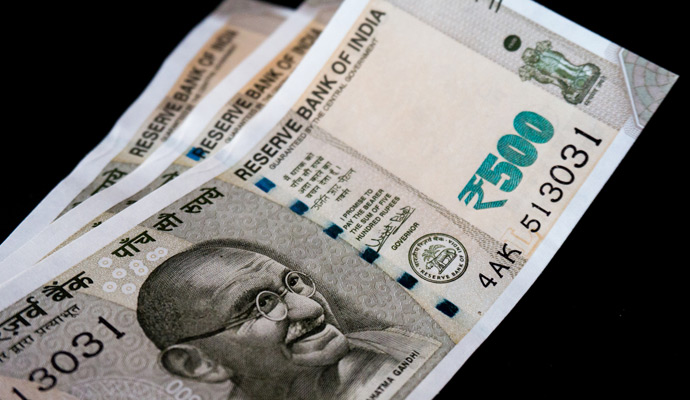What happened after India eliminated cash
In 2016, the Indian government abruptly wiped out most of the nation’s currency in hopes of ending black money and curbing corruption. Has the experiment worked?
On the night of Nov. 8, 2016, there was a surprise announcement on Indian television. In a live telecast to the nation, Prime Minister Narendra Modi declared that the country’s two highest-denomination currency notes (Rs 1,000 and Rs 500) would be withdrawn immediately from the market. The plan, termed demonetization by the press, was planned in secrecy and announced dramatically, as Modi’s masterstroke against black money.
As economic experiments go, it was a big, bold move. There was no precedent, anywhere in the world, for a sudden economic shock of this scale. The withdrawn notes, amounting to US$320 billion at the time, represented 86 percent of the total currency value in circulation in India. By making the notes worthless almost overnight, the government hoped to destroy large piles of black money hidden away by tax evaders. In addition, the government claimed the plan would strike a major blow against corruption and counterfeiting and would kick-start India’s transition into a digital, cashless world. In a country with a huge informal economy, dependent on cash transactions, demonetization was a big political gamble, too.
The immediate fallout was chaos, as the country scrambled to cope. There was a rush at banks and ATMs to exchange old notes and withdraw new currency. Queues at banks grew; many people suffered, especially the poor, who had no access to credit cards or mobile wallets; and dozens of deaths resulting from the crisis were reported.
Two years later, the dust has settled, and it has become obvious that demonetization was not the resounding success the government expected it to be. India’s black money problem has not gone away. The economy has taken a beating, huge financial losses have been incurred, and the marginalized poor, least able to withstand adversity, have been negatively affected. There have been some gains in tax collections, and the country has progressed toward digital payments, but these advances could have been achieved through other, less drastic means.
For countries tackling black money or promoting a cashless economy, India’s experience with demonetization provides rich lessons. Although the long-term social, economic, and political consequences of demonetization are still playing out in India, answers to many complex questions are now apparent.
What Happened to the Black Money?
Economists who supported demonetization predicted that black money hoarders would destroy their stashes rather than declare them, thus delivering a bottom-line bonanza to the country. But in August 2018, the Reserve Bank of India (RBI), the country’s central bank, confirmed that 99.3 percent of the demonetized notes had been returned to the banks. Almost nothing was extinguished.
It has become obvious that demonetization was not the resounding success the government expected it to be.
Clearly, assumptions proved to be far from reality. Unlike portrayals in Bollywood films, it appeared that big tax evaders had not stashed away bundles of cash, but more likely held their money in real estate, gold, and Swiss bank accounts. Whatever was held in cash found its way back into the banking system. The press reported that the wealthy sold their currency at discounted rates to money-laundering intermediaries, who then deposited the notes into the banking system through the accounts of low-income Indians. Ultimately, the RBI did not receive any windfall. Instead, the cost of printing lower-denomination notes and managing the demonetization exercise put a sizeable dent in the central bank’s coffers, reducing its annual dividend to 46 percent of what it paid the government the previous year. There was very little counterfeit currency detected among the notes returned.
The withdrawal of Rs 1,000 and Rs 500 notes was meant to signal a tough stance against black money by making it difficult to hoard large sums of cash. However, the government immediately introduced a new Rs 2,000 note, which seemed to defeat the purpose of eliminating the other high-denomination notes. The government offered no explanation for the move. And counterfeits were detected in the newly printed currency within a month of demonetization, suggesting that the counterfeiting network quickly adapted.
What Happened to Economic Growth?
The abrupt withdrawal of cash from India’s economy, without adequate or timely replenishment, hurt the farming and industrial sectors. Demand for goods and services fell immediately after demonetization. Segments that relied on cash transactions — such as agriculture, organized and unorganized retail, and the micro, small, and medium enterprise (MSME) sector — suffered most. A November 2017 study of 3,000 regulated agricultural markets for 35 major agricultural commodities, conducted during the three months immediately following demonetization, concluded that eliminating the high-currency notes had reduced the value of domestic agricultural trade by more than 15 percent in the short run, settling at 7 percent reduction three months later. The implementation of a nationwide goods and services tax (GST) in July 2017 provided yet another major economic disruption.
The Centre for Monitoring Indian Economy (CMIE), a private forecaster, estimated that 1.5 million jobs were lost between January and April 2017. The labor force further shrank from 439.7 million in the fiscal year 2016–17 to 426.1 million in 2017–18. And the labor force participation rate (which expresses the labor force as a percentage of the working-age population) fell from 46.1 percent to 43.5 percent. According to CMIE, those ages 15 to 24 were the most affected, probably because they were relatively new to the workforce and typically held low-skilled, informal jobs paid by cash.
According to the RBI, India’s GDP growth rate slowed from 8 percent in 2015–16 to 7.1 percent in 2016–17, to 6.7 percent in 2017–18. And the Central Statistics Office of the Government reported that during the first quarter of the fiscal year 2018–19 (April to June 2018), India’s GDP registered growth of 8.2 percent, on the back of a good performance by the manufacturing and farming sectors. However, it might be premature to celebrate this as an indicator that the country is bouncing back to pre-demonetization levels. Tighter financial conditions, high oil prices, and slowing global growth are expected to slow GDP growth again in the second half of this fiscal year, which has led the RBI to forecast GDP growth at 7.4 percent for 2018–19. Although this is still high compared with world trends, the country’s economic performance would have been better without the dampening effects of demonetization.
Did Tax Collections Improve?
Excluding the effects of a tax amnesty plan launched months before demonetization, government data shows there was no major growth in tax collections in the 2016–17 financial year. In the next financial year, though, both the number of taxpayers and direct tax collections grew significantly, by 10 percent and 19 percent, respectively. Tax buoyancy (tax collection growth after factoring in GDP growth) also improved. The Finance Ministry announced in August 2018 that the tax department was scrutinizing 1.8 million accounts, totaling $40 billion. However, in a country notorious for large-scale corruption, it remains to be seen whether the scrutiny will yield concrete results.
Without complex economic and behavioral modeling, it’s difficult to isolate the effect of amnesty plans, demonetization, GST, and tax administration reforms on tax compliance and collections. But direct and indirect tax data for 2017–18 suggests that India is making progress on the path to a more formal, tax-compliant economy.
Did India Move Closer to a Cashless Economy?
The Indian economy traditionally has been dominated by cash. According to an April 2018 World Bank report (pdf), 190 million adult Indians do not have bank accounts. Even among those with bank accounts, many are still poor and illiterate, with no access to credit or debit cards or Internet banking.
In the months following demonetization, when cash became unavailable, there was a sharp rise in debit and credit card transactions. Those who did not have cards applied for them, but it was difficult to get new cards quickly. Mobile wallets, with simpler documentation and Know Your Customer (KYC) requirements, stepped in to bridge the gap. Paytm, an Indian startup, quickly became the market leader, allowing merchants to register even without a bank account.
Although initial enthusiasm for mobile wallets has tapered off, it sparked adoption of mobile payments, particularly for low-value transactions. Paytm announced in July 2018 that it had more than 100 million active users, with gross transactions totaling $50 billion in a year (with an average transaction value of $10). Several other big players have entered the market and reported strong growth. Multiple tailwinds — the increased penetration of affordable smartphones, the growth of e-commerce, improvements in telecom and payment infrastructure, and the availability of multilingual wallets — are pushing this growth in mobile wallets.
However, mobile wallets represent less than 5 percent of the total value of retail digital transactions in India. More than 85 percent of retail electronic transfers (in terms of value) are done using the National Electronic Funds Transfer (NEFT) platform, which enables individuals and businesses to transfer funds across bank accounts. NEFT showed growth of 44 percent in 2016–17 and 43 percent in 2017–18. This is in keeping with the increasing value of NEFT transactions over the last five years (with a CAGR of 42 percent from 2013 to 2018). So, it appears that although electronic NEFT payments continue to grow steadily in India, demonetization has not really accelerated the rate of growth.
India’s love affair with cash also remains strong. ATM withdrawals dropped in 2016–17, but picked up pace when currency was freely available again. A July 2018 PwC report (pdf) on ATMs in India shows that from April 2017 to March 2018, the average month-on-month growth in ATM transaction values was 1.16 percent, compared with 1.04 percent from May 2014 to October 2016 (pre-demonetization). According to the RBI, currency in circulation grew by 37 percent in 2017–18, and the currency-to-GDP ratio increased from 8.8 percent to 10.9 percent. The real estate sector, known for large cash transactions, experienced a major setback immediately after demonetization, but cash has now begun to make its appearance in property and land deals.
It is reasonable to conclude from the data that India is on a journey toward digital payments, with demonetization providing a positive nudge. But cash remains king; and many Indians remain outside the ambit of digital transactions.
What About the Common Person?
In the days after demonetization was announced, the press carried harrowing stories of human suffering. The shortage of cash resulted in medical and personal emergencies. Several tragedies were reported. The prime minister appeared on television, acknowledging the anguish, and called on the people to join him on a mahayagna, a grand sacrifice to rid India of corruption. It appeared that many Indians bought into the idea of a war on corruption. Even through many days of widespread distress, there were no major riots or violent incidents.
Several academicians and activists documented the impact of demonetization on the rural poor. A study of 492 households from 10 villages in the southern Indian state of Tamil Nadu reported that more than one-third of those surveyed had less work after demonetization. Agricultural wage workers and the self-employed suffered the greatest effects. Several people reported permanent loss of work, or loss of markets, as they were replaced by competitors who adapted better to being cashless. As cash disappeared, people relied more strongly on networks of friends and family to sustain their economic and social activities. Informal debt rose sharply. Those without such support networks suffered the most, particularly because state social protection is weak in India and governmental programs are notoriously subject to patronage.
A survey of 200 families living in 28 slum neighborhoods in Mumbai, conducted in December 2016 and February 2017, showed that 40 percent of households reported losing about 40 percent of their monthly income due to demonetization. Consumption and savings decreased, household debt increased, and the ability to repay debt worsened. Respondents reported an increased acceptance of cashless payment methods, but cash remained the preferred payment form. The attitude toward different forms of savings changed significantly, with respondents showing a decreased willingness to hold cash at home. In spite of income losses, at the beginning of February 2017, 51 percent of the sample surveyed felt positive about demonetization, feeling it was for the good of the country, while 22 percent had a negative opinion.
What Were the Political Implications?
Modi’s Bharatiya Janta Party (BJP) came to power in 2014 with a strong majority mandate, allowing him to take a political gamble with demonetization. If black money had indeed been extinguished in a significant way, it would have established Modi as a champion of the poor and consolidated his party’s hold on the electorate. Demonetization turned out to be a damp squib, though, and dented Modi’s image as a leader who could do no wrong. Nonetheless, the BJP won assembly elections in eight of the 12 states that went to the polls in 2017 and 2018. It seems that neither poor economic performance nor the combined shocks of demonetization and GST have halted BJP’s journey toward becoming India’s leading national party.
The Final Verdict
The Indian government issued a press statement in August 2018, claiming that demonetization was a success. The facts do not support the claim.
If the goal of demonetization was to reduce black money, a gradual and steady withdrawal of high-denomination notes would have perhaps served the purpose better. If the objective was to make the country more tax-compliant, then it would have been better to pursue administrative reforms in taxation and increased automation of processes, along with amnesty plans and customer education. Some argue that the Tax Department now has information about who has money, and thus demonetization can help find those guilty of tax evasion. But to make use of this information, the country needs corruption-free, effective tax administration (which was part of the original problem Modi sought to correct). The success of the nationwide GST in bringing more people under the tax net, and increasing both direct and indirect tax collections, is proof that there are better ways to bell the cat. India is now moving faster toward cashless transactions. However, the government had been making moves to digitize before demonetization. Aadhaar (a unique identification number for each Indian), Jan Dhan (universal banking), UPI (unified payments interface), and many other initiatives were already underway. It would have been better to push through those plans gradually, bearing in mind the needs of the weakest sections of society.
In a largely informal economy where the most vulnerable people still have no access to digital payments, demonetization was an ill-considered, draconian measure that did a lot of damage to the Indian economy. At the end of two years, the benefits do not seem to have been worth the enormous financial losses and suffering.





